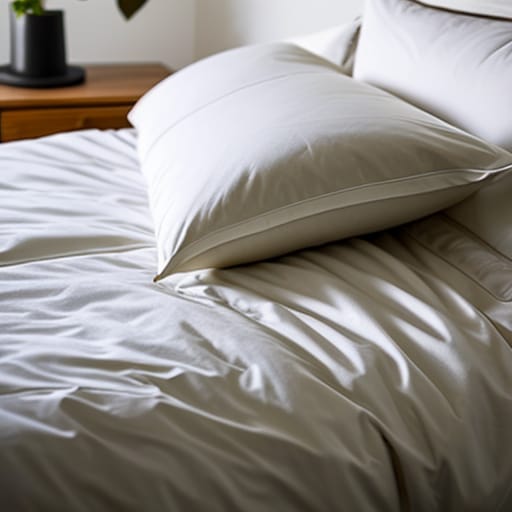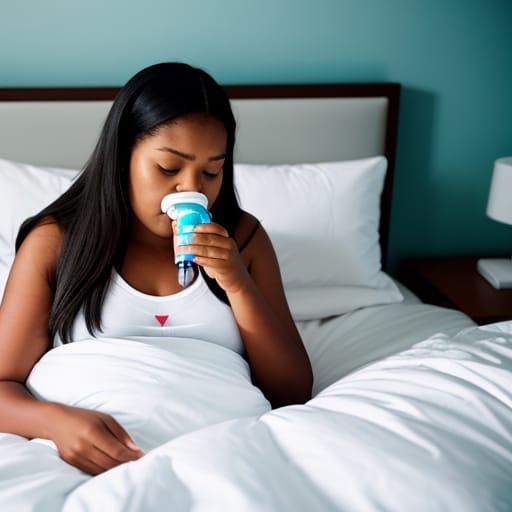When it comes to selecting the best bedding for a comfortable night’s sleep, many people consider buying a down comforter. These comforters are known for providing exceptional warmth and plush comfort. However, if you suffer from allergies like asthma or react negatively to dust mites, you may be wondering: are down comforters bad for allergies?
This comprehensive guide will discuss key aspects related to down comforters and allergies. You’ll learn about:
- The link between down bedding and allergic reactions
- Health risks and safety considerations
- Alternatives for allergy sufferers
- Tips for choosing the right down comforter
- Recent research and medical studies
- Prevention and management guidance
Let’s start by understanding exactly what down comforters are and their association with common allergies.
What Are Down Comforters?
A down comforter is a type of duvet or quilt filled with the fine, soft under feathers of ducks or geese. This natural down filling offers exceptional insulation to keep you warm and comfortable at night.
Down comforters provide exceptional warmth and comfort thanks to their natural filling. But are they suitable for those with allergies?
The fluffy texture and lightweight nature of down make it superior to other fillings like cotton or wool when it comes to heat retention and breathability. High-quality down can last over a decade with proper care.
However, the concern when it comes to down comforters and allergies lies in the dust mites, feathers, and dander present within them. Let’s analyze this further.
Prevalence of Allergies and Asthma
Allergies are extremely common health conditions worldwide.
- Over 50 million Americans suffer from various types of allergies each year
- Around 8% have been diagnosed with respiratory allergies and diseases like hay fever
- 10% of US adults have been diagnosed with asthma
The most common allergy and asthma triggers include:
- Dust mites
- Pet dander
- Pollen
- Mold spores
- Certain food items
Could our bedding and down comforters also be a source of constant allergen exposure leading to reactions?
Do Down Comforters Aggravate Allergies?
So, is sleeping under a warm, fluffy down comforter safe when you have respiratory allergies and asthma? Let’s analyze if down bedding poses allergy risks.
Why Down Fillings Cause Allergic Reactions
Feathers and down contain a specific protein called DerP1 that most people are allergic to. Allergens can become airborne when sleeping under feather bedding.
The light, fluffy texture of down fillings means feathers and dander often separate and become airborne within the comforter. This gets worse with regular use over time.
Microscopic dust mites thrive on the skin cells shed by humans inside bedding. Most down comforters provide the perfect warm, humid environment for them to proliferate rapidly.
Bacteria and fungal growth is also common over years of use.
All these allergens and irritants can be inhaled while sleeping under down comforters. For those already suffering from respiratory issues, these particles can trigger severe allergic reactions and asthma attacks.
Let’s analyze the health repercussions further.
Concerns About Feather Duvet Lung Disease
The condition called feather duvet lung disease refers to a type of hypersensitivity pneumonitis caused by bedding materials. The symptoms are similar to continuous asthmatic reactions.
Some documented risks include:
- Chronic coughing and breathlessness
- Lung inflammation and respiratory damage
- Hypersensitivity pneumonitis leading to lung fibrosis
One case study described a patient named Dempsey who suffered from this condition after sleeping under a feather duvet for years. His symptoms only improved after removing the feather bedding permanently.
Clearly, the hazards of lower respiratory problems are real when using down comforters regularly in the long term.

Factors that Impact Health Risks
However, it’s important to remember that the risks can vary substantially based on:
- Allergen load in the comforter fillings
- Thread count and shell fabric
- Frequency of washing and sanitization
- Sensitivities of the individual
Lower-grade down bedding with more impurities and allergens tends to pose higher irritation risks. Paying more for pure, hypoallergenic down can reduce hazards.
Qualities like the shell fabric, fill power, and allergy-free warranties offered by brands should be evaluated when shopping for down comforters.
For asthma and allergy sufferers, being aware of these aspects can make a difference in managing health risks.
Now let’s explore some alternative options to consider.
Allergy-Friendly Alternatives to Down Comforters
Instead of traditional down bedding, some suitable options for people sensitive to allergens include:
- Synthetic down comforters – Filled with microfiber/polyester instead of natural down and feathers. Tend to be cheaper as well.
- Cotton comforters – Breathable, hypoallergenic, and machine-washable. Don’t offer as much warmth as down.
- Wool comforters – Natural fabric good for temperature regulation and moisture-wicking. Can be expensive.
- Bamboo comforters – Made from bamboo viscose rayon. Somwhat breathable and antimicrobial.
- Silk comforters – Extremely smooth, breathable fabric. Often blended with cotton for affordability.
| Type | Fill Material | Price | Warmth | Breathability | Hypoallergenic |
|---|---|---|---|---|---|
| Down | Goose/duck feathers | $$$ | ⭐⭐⭐⭐⭐ | ⭐⭐⭐ | ❌ |
| Synthetic | Microfiber/polyester | $ | ⭐⭐⭐ | ⭐⭐⭐⭐ | ✅ |
| Cotton | Cotton | $$ | ⭐⭐ | ⭐⭐⭐⭐ | ✅ |
| Wool | Wool | $$$ | ⭐⭐⭐ | ⭐⭐⭐ | ✅ |
| Bamboo | Bamboo viscose | $$ | ⭐⭐⭐ | ⭐⭐⭐ | ⭐⭐ |
| Silk | Mulberry silk | $$$ | ⭐⭐ | ⭐⭐⭐⭐⭐ | ⭐⭐⭐⭐ |
The choice depends on your budget, sleep needs, and level of sensitivity to allergens. Testing out different comforter types to see what works best for your needs is wise.
Next, let’s go over some vital guidance allergy sufferers should keep in mind.
Tips for Allergy Sufferers When Selecting Down Bedding
Those sensitive to dust mites and feather allergens should remember:
- Check labels for clearly stated hypoallergenic certifications before purchasing
- Choose options with barrier weave fabrics which limit fill leakage
- Look for quality indicators like high thread count, fill power, and more
- Wash regularly using hot water and fragrance/allergen free detergents
- Dry clean down bedding at least once annually to deep clean
- Avoid feather pillows and use hypoallergenic versions instead
Taking some precautions can help minimize allergy triggers from down comforters significantly.
Latest Medical Research and Studies
Recent medical research also sheds some light on this topic:
A 2021 study published in Annals of Allergy, Asthma & Immunology examined feather allergy prevalence in over 500 patients. Nearly one-third showed positive skin prick reactions to feather allergens.
Another 2022 study in the Journal of Investigational Allergology and Clinical Immunology found that 20% of adult allergy patients showed IgE sensitization to feathers. The data suggests feather allergies are in fact less uncommon than previously assumed.
More clinical research is still required to establish conclusive links between downbedding and respiratory issues. However existing evidence does indicate paying attention to feather and dust mite allergies is vital for some individuals.
Prevention Strategies and Guidance
To conclude, how can you prevent and manage allergies from down bedding? Here are some top tips:
- Encase mattresses and pillows in dust mite proof covers
- Wash bedding weekly in hot, soapy water to kill allergens
- Vacuum carpets and upholstery regularly using a HEPA filter
- Use a dehumidifier to keep bedroom humidity under 50%
- Limit feather bedding and opt for hypoallergenic versions

The Bottom Line: Choose Wisely Based on Your Needs
While down comforters pose some allergy and asthma risks, the hazards can be managed by selecting high-quality products and taking suitable precautions.
If you suffer from feather or dust mite allergies, play it safe by opting for a synthetic down alternative comforter instead. For better peace of mind regarding health risks, hypoallergenic options remain the best bet.
With some prudent selection tips and preventative measures, you can still enjoy snuggling under a warm, comfy down comforter without allergy woes or asthma flare-ups.
Frequently Asked Questions
Is my down comforter making my allergies or asthma worse?
For some individuals, yes – the feathers, dust mites, and animal dander within down comforters can trigger allergic reactions or asthma symptoms. Look out for signs of respiratory irritation like wheezing, stuffy nose, and trouble breathing. Consider switching to a hypoallergenic synthetic comforter and see if it helps provide allergy relief.
How do I know if I’m actually allergic to the down filling in my comforter?
Some key signs pointing to a likely feather allergy include skin redness, itchiness, eye irritation, runny nose, coughing, and worsened asthma when sleeping under or touching feather bedding. Getting medically tested by an allergist can help confirm hypersensitivity through skin or blood tests.
Is it OK to just put a duvet cover over my down comforter?
Using a duvet cover can help act as a barrier to contain some allergens, but small dust mites and lightweight feathers can still escape through sewing holes over time. So while a cover adds some protection, it doesn’t eliminate the risk of allergic reactions. Washing the cover weekly is also essential.
Do all down alternative comforters mean they are hypoallergenic?
No – you need to verify if a synthetic polyester comforter is specifically labeled as ‘hypoallergenic‘ to ensure the materials used don’t trigger allergies. Some cheaper polyester fillings still contain impurities that can bother those sensitive to dust mites. Check product details closely before buying.
How often should I wash my down comforter to limit allergens?
To reduce buildup of irritating particles like feathers, dander and dust mites, wash your down comforter at least 2-3 times a year according to manufacturers’ instructions. For severe allergy or asthma sufferers, consider washing monthly. Use hot water washes around 130°F with mild detergent and extra rinse cycles to remove residues thoroughly.








